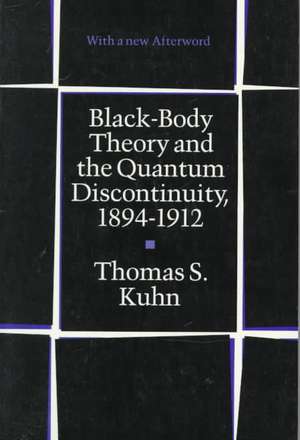Black-Body Theory and the Quantum Discontinuity, 1894-1912
Autor Thomas S. Kuhnen Limba Engleză Paperback – 15 ian 1987
"A masterly assessment of the way the idea of quanta of radiation became part of 20th-century physics. . . . The book not only deals with a topic of importance and interest to all scientists, but is also a polished literary work, described (accurately) by one of its original reviewers as a scientific detective story."—John Gribbin, New Scientist
"Every scientist should have this book."—Paul Davies, New Scientist
"Every scientist should have this book."—Paul Davies, New Scientist
Preț: 366.99 lei
Nou
Puncte Express: 550
Preț estimativ în valută:
70.23€ • 75.09$ • 58.55£
70.23€ • 75.09$ • 58.55£
Carte tipărită la comandă
Livrare economică 17 aprilie-01 mai
Preluare comenzi: 021 569.72.76
Specificații
ISBN-13: 9780226458007
ISBN-10: 0226458008
Pagini: 398
Dimensiuni: 152 x 229 x 33 mm
Greutate: 0.53 kg
Ediția:1
Editura: University of Chicago Press
Colecția University of Chicago Press
ISBN-10: 0226458008
Pagini: 398
Dimensiuni: 152 x 229 x 33 mm
Greutate: 0.53 kg
Ediția:1
Editura: University of Chicago Press
Colecția University of Chicago Press
Notă biografică
Thomas S. Kuhn is the Laurance S. Rockefeller Professor of Philosophy in the Department of Linguistics and Philosophy at the Massachusetts Institute of Technology. His books include The Structure of Scientific Revolutions and The Essential Tension, both published by the University of Chicago Press, and The Copernican Revolution.
Cuprins
Part One. Planck's Black-Body Theory, 1894-1906: The Classical Phase
I. Planck's Route to the Black-Body Problem
The Black-Body Problem
Planck and Thermodynamics
Planck and the Kinetic Theory of Gases
Planck and the Continuum and Electromagnetism
II. Planck's Statistical Heritage: Boltzmann on Irreversibility
Boltzmann's H-Theorem
The First Interpretation of the H-Theorem
Loschmidt's Paradox and the Combinatorial Definition of Entropy
The Conflation of "Molecular" and "Molar"
Molecular Disorder
Epilogue: Molecular Disorder and the Combinatorial Definition after 1896
III. Planck and the Electromagnetic H-Theorem 1897-1899
Cavity Radiation without Statistics
The Entry of Statistics and Natural Radiation
Planck's "Fundamental Equation"
Entropy and Irreversibility in the Field
IV. Planck's Distribution Law and Its Derivations, 1900-1901
Planck's Uniqueness Theorem and the New Distribution Law
Recourse to Combinatorials
Deriving the Distribution Law
The New Status of the Radiation Constants
V. The Foundations of Planck's Radiation Theory, 1901-1906
The Continuity of Planck's Theory, 1894-1906
Natural Radiation and Equiprobable States
Energy Elements and Energy Discontinuity
The Quantum of Action and Its Presumptive Source
Planck's Early Readers, 1900-1906
Part Two. The Emergence of the Quantum Discontinuity, 1905-1912
VI. Dismantling Planck's Black-Body Theory: Ehrenfest, Rayleigh, and Jeans
The Origin of the Rayleigh-Jeans Law, 1900-1905
Ehrenfest's Theory of Quasi-Entropies
The Impotence of Resonators
Complexion Theory and the Rayleigh-Jeans Law
VII. A New Route to Black-Body Theory: Einstein, 1902-1909
Einstein on Statistical Thermodynamics, 1902-1903
Fluctuation Phenomena and Black-Body Theory, 1904-1905
Einstein on Planck, 1906-1909
VIII. Converts to Discontinuity, 1906-1910
Lorentz's Rome Lecture and Its Aftermath
Planck on Discontinuity, 1908-1910
The Consolidation of Expert Opinion: Wien and Jeans
IX. Black-Body Theory and the State of the Quantum, 1911-1912
The Decline of Black-Body Theory
The Emergence of Specific Heats
Quanta and the Structure of Radiation
The Quantum and Atomic Structure
The State of the Quantum
Part Three. Epilogue
X. Planck's New Radiation Theory
Planck's "Second Theory"
Revising the Lectures
Some Uses of the Second Theory
The Fate of the Second Theory
Notes
Bibliography
Afterword: Revisiting Planck
Index
I. Planck's Route to the Black-Body Problem
The Black-Body Problem
Planck and Thermodynamics
Planck and the Kinetic Theory of Gases
Planck and the Continuum and Electromagnetism
II. Planck's Statistical Heritage: Boltzmann on Irreversibility
Boltzmann's H-Theorem
The First Interpretation of the H-Theorem
Loschmidt's Paradox and the Combinatorial Definition of Entropy
The Conflation of "Molecular" and "Molar"
Molecular Disorder
Epilogue: Molecular Disorder and the Combinatorial Definition after 1896
III. Planck and the Electromagnetic H-Theorem 1897-1899
Cavity Radiation without Statistics
The Entry of Statistics and Natural Radiation
Planck's "Fundamental Equation"
Entropy and Irreversibility in the Field
IV. Planck's Distribution Law and Its Derivations, 1900-1901
Planck's Uniqueness Theorem and the New Distribution Law
Recourse to Combinatorials
Deriving the Distribution Law
The New Status of the Radiation Constants
V. The Foundations of Planck's Radiation Theory, 1901-1906
The Continuity of Planck's Theory, 1894-1906
Natural Radiation and Equiprobable States
Energy Elements and Energy Discontinuity
The Quantum of Action and Its Presumptive Source
Planck's Early Readers, 1900-1906
Part Two. The Emergence of the Quantum Discontinuity, 1905-1912
VI. Dismantling Planck's Black-Body Theory: Ehrenfest, Rayleigh, and Jeans
The Origin of the Rayleigh-Jeans Law, 1900-1905
Ehrenfest's Theory of Quasi-Entropies
The Impotence of Resonators
Complexion Theory and the Rayleigh-Jeans Law
VII. A New Route to Black-Body Theory: Einstein, 1902-1909
Einstein on Statistical Thermodynamics, 1902-1903
Fluctuation Phenomena and Black-Body Theory, 1904-1905
Einstein on Planck, 1906-1909
VIII. Converts to Discontinuity, 1906-1910
Lorentz's Rome Lecture and Its Aftermath
Planck on Discontinuity, 1908-1910
The Consolidation of Expert Opinion: Wien and Jeans
IX. Black-Body Theory and the State of the Quantum, 1911-1912
The Decline of Black-Body Theory
The Emergence of Specific Heats
Quanta and the Structure of Radiation
The Quantum and Atomic Structure
The State of the Quantum
Part Three. Epilogue
X. Planck's New Radiation Theory
Planck's "Second Theory"
Revising the Lectures
Some Uses of the Second Theory
The Fate of the Second Theory
Notes
Bibliography
Afterword: Revisiting Planck
Index













